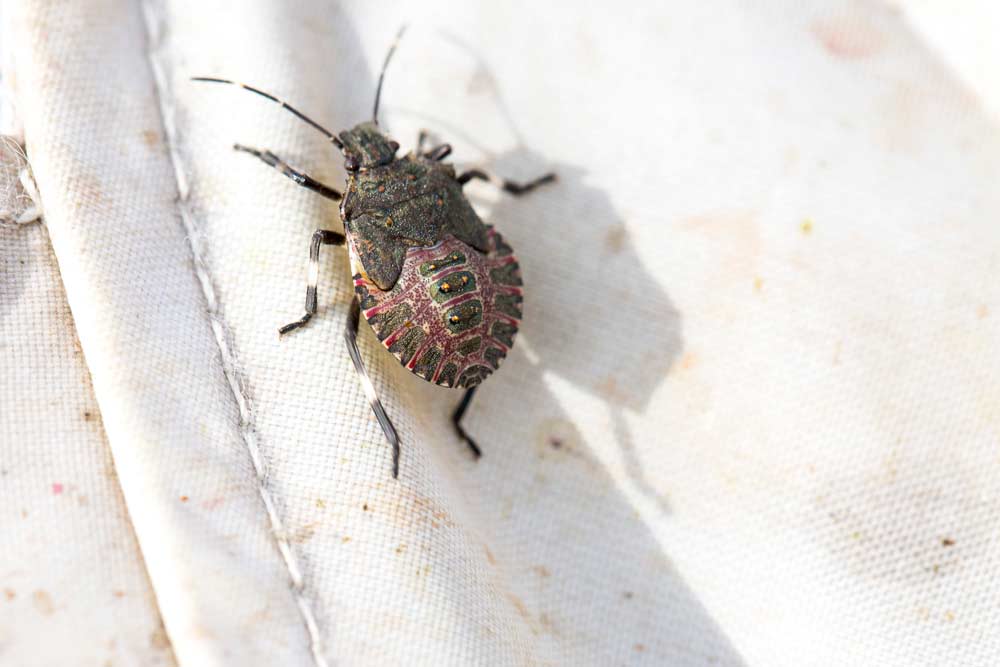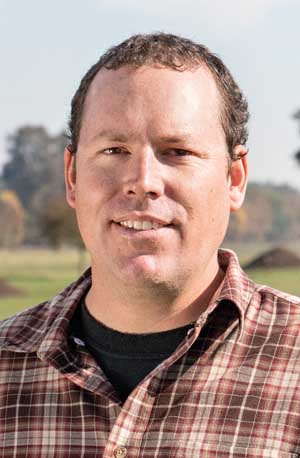
An immature brown marmorated stink bug nymph in the fifth instar stage is caught in a beating tray in 2015 in a Walla Walla, Washington, vineyard. The agricultural pest is spreading throughout the West, but researchers have had preliminary success releasing the parasitic samurai wasp, which kills the stink bug’s eggs. (TJ Mullinax/Good Fruit Grower)
The Northwest has more brown marmorated stink bug diversity than the East Coast. The pest has reached high population levels in the Walla Walla Valley. And that samurai wasp that’s supposed to save the day? It may have already worked.
Once, anyway.
Those were among the nuggets of information Nik Wiman, an Oregon State University entomologist, shared with growers at the Washington State Tree Fruit Association’s annual meeting in December.
With an overall stink bug status presentation, Wiman told the growers that researchers have confirmed that samurai wasp has established in the area of Portland and spread on its own to some surrounding areas. In one documented instance, the parasitic wasp did what everyone has been hoping — killing a mass of brown marmorated eggs.

Nik Wiman
For two years, Wiman and researchers at OSU have been releasing samurai wasps, Trissolcus japonicus, a parasitic Asian import native to the same region as brown marmorated stink bug, or BMSB, to test their effect on the rising pest population. The wasps lay eggs in BMSB egg masses, and then wasp larvae feed on the stink bug eggs. The hope is the wasp will provide a biological control for BMSB, a voracious pest for both agricultural and urban areas.
BMSB has caused significant economic losses to Mid-Atlantic apple growers. So far, prophylactic broad-spectrum insecticide applications have worked, but those throw mating disruption and other integrated pest management programs out of whack. “We don’t want to be applying these willy-nilly to our orchard systems,” Wiman said.
In 2016, university staff released 50 female wasps at six sites. In 2017, they bumped up their game, deploying 40 females per site at 24 sites, focusing on areas with host plants susceptible to BMSB in orchard regions between May and August. With those females, they also placed sentinel BMSB egg masses, raised in their laboratory, just to make sure the wasps were viable. The egg masses can be brought back to the laboratory and the wasps can be reared out of the eggs. In at least 13 release sites, the wasp was successfully recovered, suggesting they established populations. At five other sites the researchers found the wasp in places they did not release it.
In another case, an alert Master Gardener found a wild BMSB egg mass turned black and reported it to the university’s website. Researchers confirmed it was caused by the samurai wasp, which they were able to rear out and identify from the egg mass in the lab.
That means the plan worked at least once.
In other stinky news, Wiman said, BMSB is getting around.
Oregon’s Willamette Valley is still the Northwest hotspot, so much so that researchers don’t even bother much tracking movements there.
But populations have been growing elsewhere, too. The pests have reached high levels in the Walla Walla Valley and in Milton-Freewater, home to sweet cherries, apples and lots of wine grapes. “The Walla Walla Valley on the Washington side has massive populations of this pest now, so in terms of economic impacts that’s kind of where I would expect it to hit Washington first,” Wiman said.
Also, the bug has been showing up in pear orchards and packing houses near Hood River in the Columbia River Gorge, making growers “a little panicky,” he said. Folks have also reported stink bug damage in Jackson County in southern Oregon, a pear growing region, though entomologists have not yet confirmed it is the brown marmorated. The Pacific Northwest is home to more than 30 native stink bug species. Some are pests; a few are predators.
Meanwhile, Wiman and researchers are learning more about how BMSB moves about the country.
They know it came from Asia, probably hitting Europe in Switzerland, Hungary and Greece, then the East Coast of America. It usually invades homes and ornamental plants first, then moves to agricultural land. In 2010, it caused major apple damage in the Mid-Atlantic region.
On the West Coast, it was first detected in 2004 in Oregon, which has suffered economic losses, too. Wiman and his experts have confirmed such stories of relocating East Coast families finding the bug pouring out of their U-hauls when they arrive at their new homes in Washington’s Puget Sound area.
“We know they’re very good hitchhikers,” he said.
However, recent studies of DNA have determined that the BMSB population in the Northwest seems to have at least four distinct genetic groups, as opposed to just one in the East, leading them to speculate that unique populations are arriving straight from Asia through ports. Oregon has unwittingly shipped them to California, and the Mid-Atlantic seems to be returning the favor and sending them to Italy, where the bugs have reached infestation levels in peach orchards.
As for how they interact with orchards, Wiman has more work to do, he said.
They know BMSB eats both fruit and the vegetative portion of trees. For that matter, the pest eats nearly anything. But erratic results from surveys and traps have him doubting whether growers can reliably use traps to guide spray regimens.
With cherries, populations continue to build up in orchards after the fruit is picked, according to Wiman’s trials. But most of the damage happens just prior to or during harvest. Season-long border traps caught more than interior traps in cherry blocks, so perhaps border treatments will work as a management strategy, he said.
In pear orchards, the population seems to peak during harvest, though damage happens in spring and early summer, dropping off in late July and picking up again in late August and September. Traps caught more in the center of blocks than on the border, the opposite pattern of cherries.
“I don’t have a lot of conclusions here other than we’re going to need a lot more data,” Wiman said. •
—by Ross Courtney






Leave A Comment